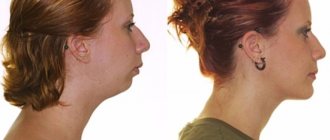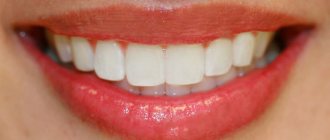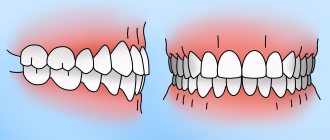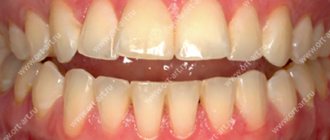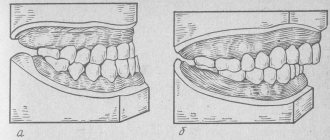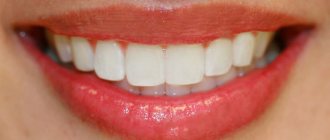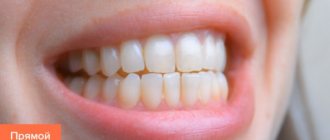There are certain criteria by which the correct bite in children is assessed. Thus, it is considered normal when the upper row of teeth overlaps the lower row by about 1/3. Malocclusion in a child is any disturbance in the occlusion of the upper and lower rows of teeth, which is fixed when the jaws are completely closed.
Considering defects in tooth growth as a cosmetic problem is fundamentally wrong. In this article we will talk not only about the types of pathologies in children, but also about their complications, treatment methods at different ages and methods of prevention.
Types of dental malocclusion in children
- Distal bite.
The lower jaw is posterior to the upper jaw
- Mesial bite.
Does the child have an incorrect bite, does the lower jaw protrude forward? This kind of bite is called mesial. In this poetic form, we can give a brief description of another common type of jaw disproportion, when the lower jaw is much more developed than the upper.
- Cross or scissor bite.
A less common, but very unpleasant dental anomaly. With a crossbite in a certain place, the jaws close in the opposite relationship - they close in reverse, which is why the dentition resembles scissors.
- Deep bite.
A very common type of malocclusion in children and adults, when the upper teeth cover the lower teeth by more than half.
- Open bite.
One of the most complex anomalies, causing physical and psychological discomfort to the child. The upper and lower rows of teeth cannot meet completely, causing a noticeable gap to form between them.
Above we described what a child’s malocclusion looks like in various manifestations, but we should also briefly talk about the correct one, which can be perceived as a kind of guideline. The ideal bite is considered orthognathic. It is distinguished by an absolutely even dentition without gaps, curvature or crowding, when the upper teeth cover the lower ones by one third. There are several types of correct bite, but if your child has dental defects, this almost always indicates problems.
Diagnostics
Even if parents carefully monitor all the signs of malocclusion in their child, they will not notice them at the initial stage. This can only be done effectively by a dentist, to whom the boy or girl should be taken for preventive examinations every six months. This period is enough for the bite to begin to change, but not to deform significantly. Such examinations can begin at the age of two.
If problems are detected, the dentist will refer the patient for a consultation with a pediatric orthopedist. A visit to an otolaryngologist, speech therapist, or periodontist may also be necessary.
Comprehensive diagnostics may include the following components:
- panoramic image (orthopantomogram);
- X-ray of the skull in a lateral projection (teleroentgenogram);
- photo of the face in front and profile;
- making a model of the dentition based on a cast;
- computed tomography of the temporomandibular joint;
- myography of facial muscles.
All data obtained will allow us to determine the size of the problem and develop a treatment regimen.
How to determine malocclusion in a child?
“How can you tell if a child has a malocclusion?” - This is a question many parents ask. It is important to understand that only an experienced pediatric orthodontist can make an accurate diagnosis here, so we strongly advise you to undergo regular preventive examinations with this specialist from a very early age until the complete replacement of baby teeth with molars. If the baby teeth are located too closely together, this can also become an additional complication when the molars erupt (the latter take up more space because they are larger). In the case of a small child (under 3 years old), it is difficult to be guided by purely visual principles and determine by eye whether the bite is correct or incorrect. Be that as it may, there are a number of signs that directly or indirectly indicate that the child has prerequisites for orthodontic anomalies.
Improper breathing
The child's mouth is constantly in a half-open position, he does not breathe through his nose (of course, if there are no colds).
Snore
If your baby constantly snores in his sleep, this may also be one of the consequences of the development of malocclusion.
Jaw formation
Pay attention to how the child's jaws are formed. Ideally, there should be no noticeable disproportion between the top and bottom. Additionally, if a child continually pushes their lower jaw forward, this is considered a clear sign of pediatric bite problems.
Postural disorders
If your child has postural and spinal problems, this may affect the development of malocclusions.
Reviews
We work every day to ensure that you are satisfied with the quality of services provided by the Natadent clinic. By receiving your feedback, we make sure that we are on the right track.
LEAVE FEEDBACK
Causes of malocclusion in children
The causes of malocclusion in children can vary, and most of them are difficult to address without orthodontic treatment. Below you can see a list of the key reasons for the occurrence of such anomalies in a child.
Genetics.
If you are wondering why your child has an incorrect bite, look at yourself first. Genetic predisposition is the most obvious and common cause of malocclusion in a child. If one or both parents have pronounced anomalies, then with a very high degree of probability their children will inherit them.
Bad habits.
Children often chew and put into their mouths literally everything they can get their hands on. Often such cravings provoke a violation of the formation and development of teeth. Malocclusion in a child from a pacifier is also quite common.
Breathing problems.
Children with nasal breathing disorders are much more likely to suffer from malocclusion, as experts say.
Problems with the musculoskeletal system.
The spine is the main “bearing structure” of our body, so it is not surprising that the functioning of the musculoskeletal system affects the dental system.
Other diseases.
The risk group (meaning malocclusion) also includes children with diabetes mellitus and central nervous system diseases.
Why correct your bite?
Malocclusion is fraught with the following problems:
- crowded teeth;
- development of caries and gum inflammation;
- increased wear of certain groups of teeth;
- lack of space for a new tooth and delayed eruption;
- inharmonious and asymmetrical facial profile;
- speech impairment;
- violation of the aesthetics of a smile.
In addition, a child with a malocclusion may be bothered by headaches and have problems with chewing, which in turn can cause pathologies of the digestive system and gastrointestinal tract. These problems will spill over into adulthood and can significantly ruin it.
Treatment of malocclusion in children
What to do if a child has an incorrect bite? Of course, start treatment immediately! Unlike adults, where malocclusions can only be corrected with braces or aligners (and in severe cases, surgery is often necessary), malocclusions in children are treated in a variety of ways. The technique depends on the age of the child and the specific clinical case. Below is a table showing possible treatment technologies for children of different age groups.
Malocclusion in a child under one year old
For very young children (up to 1 year), it is important to choose special orthodontic nipples for feeding, and also try to refuse pacifiers, which can negatively affect the development of teeth.
Malocclusion in a child aged 1–2 years
At this age, milk teeth begin to actively erupt, so the baby can already be taken to the orthodontist. When there is a potential malocclusion in a one-year-old child, special dental guards are often required to reduce the likelihood of developing malocclusions due to chewing habits.
Malocclusion in a child from 3 to 7 years old
By age 3, a child's primary teeth will usually have fully erupted, so correction of orthodontic problems can begin if necessary. At this age, to correct the bite, removable plates, trainers and LM activators are usually used, which are designed to straighten, expand or narrow the dentition, as well as improve diction.
Malocclusion in a child 8–9 years old
8 - 9 years are considered the borderline age when active replacement of primary teeth with molars occurs. It is important here that the process goes as smoothly and successfully as possible. To correct the dentition, the same trainers and plates can be used, as well as special orthodontic devices that ensure the correct interaction of the elements of the dental system, including muscles and soft tissues.
Malocclusion in a child 10–11 years old
At the age of 10, many children have a completely new set of teeth, so this age is considered the minimum acceptable age to start wearing braces. Today in orthodontics, aligners are also widely used - removable transparent aligners for correcting malocclusion.
Why is it important to start treatment on time?
The child’s dental system is in the stage of growth and formation. It is sensitive to external influences, which allows you to achieve good results in a short time. In addition, children quickly adapt to everything new and easily get used to the devices. Treatment usually lasts several months. As prescribed by the doctor, the child wears the orthodontic structure around the clock or only at night. Treatment with removable equipment often allows you to completely eliminate the existing anomaly, or significantly reduce, reduce the cost and simplify treatment using braces.
Consequences of malocclusion in a child
Unfortunately, it is still not uncommon for parents to have no idea what the dangers of malocclusion in children are and are rather irresponsible about their dental health. Over time, the child develops malocclusions that carry with him into adulthood. In childhood, teeth are much more mobile and respond well to directed mechanical influence, while correcting a bite in an adult is a much more complex and lengthy process. Moreover, adults are much less likely to agree to treatment because of the associated inconveniences and restrictions, which over time leads to a number of complications and unpleasant consequences. An incorrect bite leads to disruption of the muscles and joints of the entire dental system, which causes characteristic clicks, spasms and pains that spread to adjacent areas and lead to migraines, hearing loss and other unpleasant manifestations. Improper functioning of the temporomandibular joint, in turn, often leads to apnea (sleep breathing disorder), which is an additional factor in the occurrence of cardiovascular diseases and leads to much more tragic consequences.
Why is malocclusion dangerous in children from a psychological point of view? If a child has serious abnormalities, this will certainly affect his self-esteem (especially in adolescence and adulthood). In the modern world, a smile is perceived as an integral part of the image of a healthy and successful person, so the issue of aesthetics in this case is also very important. As you can see, everything in our body is interconnected, so do not put off orthodontic treatment under any circumstances, especially since in childhood any problem is corrected easier and faster.
